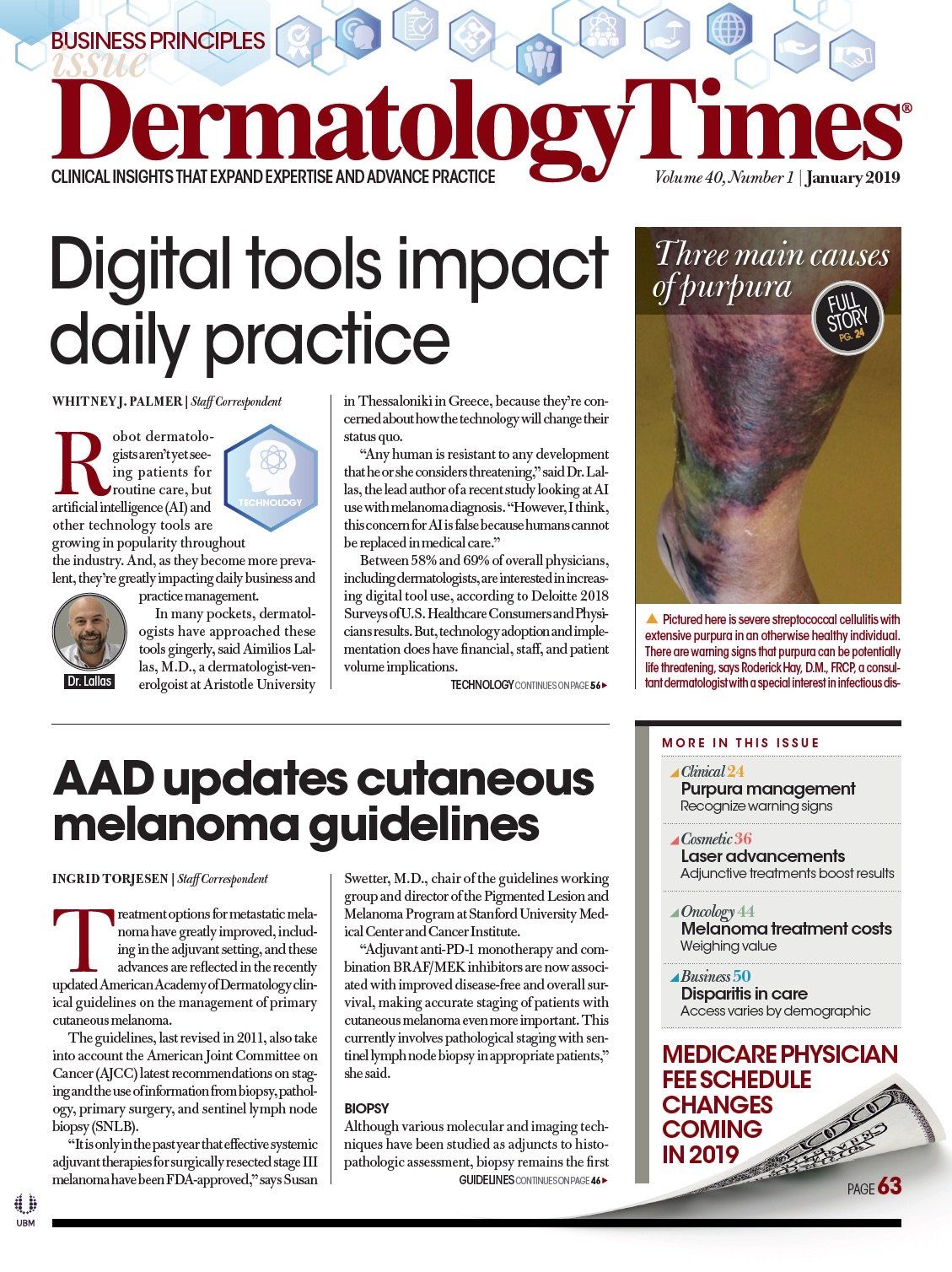- Case-Based Roundtable
- General Dermatology
- Eczema
- Chronic Hand Eczema
- Alopecia
- Aesthetics
- Vitiligo
- COVID-19
- Actinic Keratosis
- Precision Medicine and Biologics
- Rare Disease
- Wound Care
- Rosacea
- Psoriasis
- Psoriatic Arthritis
- Atopic Dermatitis
- Melasma
- NP and PA
- Skin Cancer
- Hidradenitis Suppurativa
- Drug Watch
- Pigmentary Disorders
- Acne
- Pediatric Dermatology
- Practice Management
- Prurigo Nodularis
- Buy-and-Bill
Publication
Article
Dermatology Times
Access to dermatologic care varies by demographic
Author(s):
Outpatient dermatology services can be available to any patient. However, according to recent research, that doesn’t mean all patients access or take advantage of this clinical care in the same way.
Recent research explores the patient demographics that access or take advantage of outpatient dermatological care. (©MichaelJung/Shutterstock.com).

Dr. Raghav Tripathi

Outpatient dermatology services can be available to any patient. However, according to recent research, that doesn’t mean all patients access or take advantage of this clinical care in the same way.
A new study published in JAMA Dermatology highlights the factors that affect how patients use outpatient services, including gender, age, race/ethnicity, educational level, income, insurance status, geographic region, self-reported condition, and self-reported health status.
“We’ve known for a while dermatologic conditions can cause a lot of other medical issues, and we know visits to a dermatologist reduce adverse events and improve mortality,” said Raghav Tripathi, M.D., a Case Western Reserve University School of Medicine student and first author. “But, we also know various differences exist in outcomes of conditions among different demographic groups.”
It’s important to understand the differences in how racial and ethnic groups access care, according to the study, because minorities are predicted to comprise the majority of the U.S. population by 2044. Exploring these differences can also shed light on reasons why patients from minority groups could have different dermatology experiences. For example, existing data shows minority groups have a lower level of awareness around skin conditions and understand a dermatologist’s patient-care role less.
To better understand these disparities and identify where improvements are possible, Dr. Tripathi and his team conducted a retrospective analysis of nationally representative data from 2007 to 2015. The information came from the Medical Expenditure Panel Surgery (MEPS) and was provided by the Agency for Healthcare Research and Quality. The team concentrated on data detailing services used for dermatologic conditions, including skin cancers, infections, dermatologic inflammatory conditions/ulcers, and other issues.
Of the 183,054 respondents, 19,561 self-reported a dermatologic condition. Most patients, 74,547, were non-Hispanic whites. There were 54,943 Hispanic, 36,146 African-American, and 17,418 patients from other races and ethnicities. Fifty-two percent were female.
All total, 9,654 patients accounted for 11,761 outpatient dermatology visits. Among the patients, 405 had a melanoma diagnosis, 2,045 had nonepithelial skin cancer, and 3,152 were diagnosed with skin or subcutaneous tissue infections. An additional 3,152 had other inflammatory conditions of the skin, and 870 received diagnoses of chronic skin ulcers.
The patients also received varying degrees of past dermatology care. For those with diagnosed dermatological conditions, 36.5% attended at least one outpatient dermatology visit between 2007 and 2015. The visit rate varied by diagnosis - 70.9% for melanoma, 74% for nonepithelial skin cancer, 13.2% for skin and subcutaneous tissue infection, 44.1% for other inflammatory skin conditions, and 10.6% for patients with chronic skin ulcers. Based on this data, more than twice as many non-Hispanic white patients had at least one outpatient visit compared to Hispanic or African-American patients.
According to data, Hispanic patients were less likely to receive outpatient care for dermatologic conditions relative to non-Hispanic white patients (aOR 0.55, 95% CI, 0.49-0.61). The same was true for African-American patients (aOR 0.42, 95% CI, 0.38-0.46). Additionally, males were less likely than females to undergo outpatient care (aOR 0.66, 95% CI, 0.62-0.70).
Location and insurance coverage also affected the level of dermatological care patients received, Dr. Tripathi’s team discovered. Midwestern patients received less dermatological care than patients in the Northeast (aOR 0.80, 95% CI, 0.70-0.91). Patients with private insurance were more likely to receive care. Medicare and Medicaid recipients received less care (aOR 0.75, 95% CI, 0.68-0.83), as did uninsured patients (aOR 0.39, 95% CI, 0.33-0.47).
The researchers also found higher educational levels were associated with increased odds of receiving outpatientdermatologic services. Patients with some college education (aOR 0.69, 95% CI, 0.64-0.75), a high school diploma or equivalency (aOR 0.49, 95% CI, 0.45-0.54), or no degree (aOR 0.52, 95% CI, 0.46-0.59) were less likely to undergo outpatient treatment for conditions than patients with a bachelor’s degree or higher.
Income also helped determine treatment likelihood, the study analysis revealed. High-income patients received the greatest level of care. Individuals with income levels classified as poor (aOR 0.48, 95% CI, 0.43-0.54), near poor (aOR 0.56, 95% CI, 0.48-0.66), low income (aOR 0.54, 95% CI, 0.48-0.60), or middle income (aOR 0.68, 95% CI, 0.63-0.73) had lower odds of seeing a dermatologist.
The study also highlighted healthcare expenditure differences between groups. Non-Hispanic white patients spent approximately three times as much as Hispanic and African-American patients - $209.50, $73.09, and $62.70 per capita, respectively. Per visit costs were also greater for non-Hispanic white patients than for Hispanic or African-American ones - $244.88, $191.14, and $170.94, respectively.
Investigators acknowledge possible reasons behind these disparities. Cost variances could result from different conditions affecting each group. Some healthcare institutions might not offer dermatological care, making referrals difficult. Language barriers could prevent some patients from taking advantage of services, and many patients could live in areas with low dermatologist density.
Ultimately, Dr. Tripathi said, while additional research is necessary to fully understand the disparities, he hopes these findings will encourage dermatologists to tailor their approaches to outpatient care based upon the demographic and socioeconomic characteristics of the individual patient. Dermatologists can augment outreach by making translators available, offering financial counseling, and tailoring marketing to address minority patient needs.
Dr. Tripathi also said he hopes these findings will encourage dermatologists to engage policy leaders and medical associations, encouraging them to reach out to underserved communities to improve their level of care.
“We need to be more aware of how to bring different groups back into the office so we can continue to provide the services they need,” he said.
Reference
Bordeaux JS, Ezaldein HH, Knudsen KD, Scott JF, Tripathi R, Association of Demographic and Socioeconomic Characteristics with Differences in the Use of Outpatient Dermatology Services in the United States, JAMA Dermatology (2018), doi: 10.1001/jamadermatol.2018.3114.







